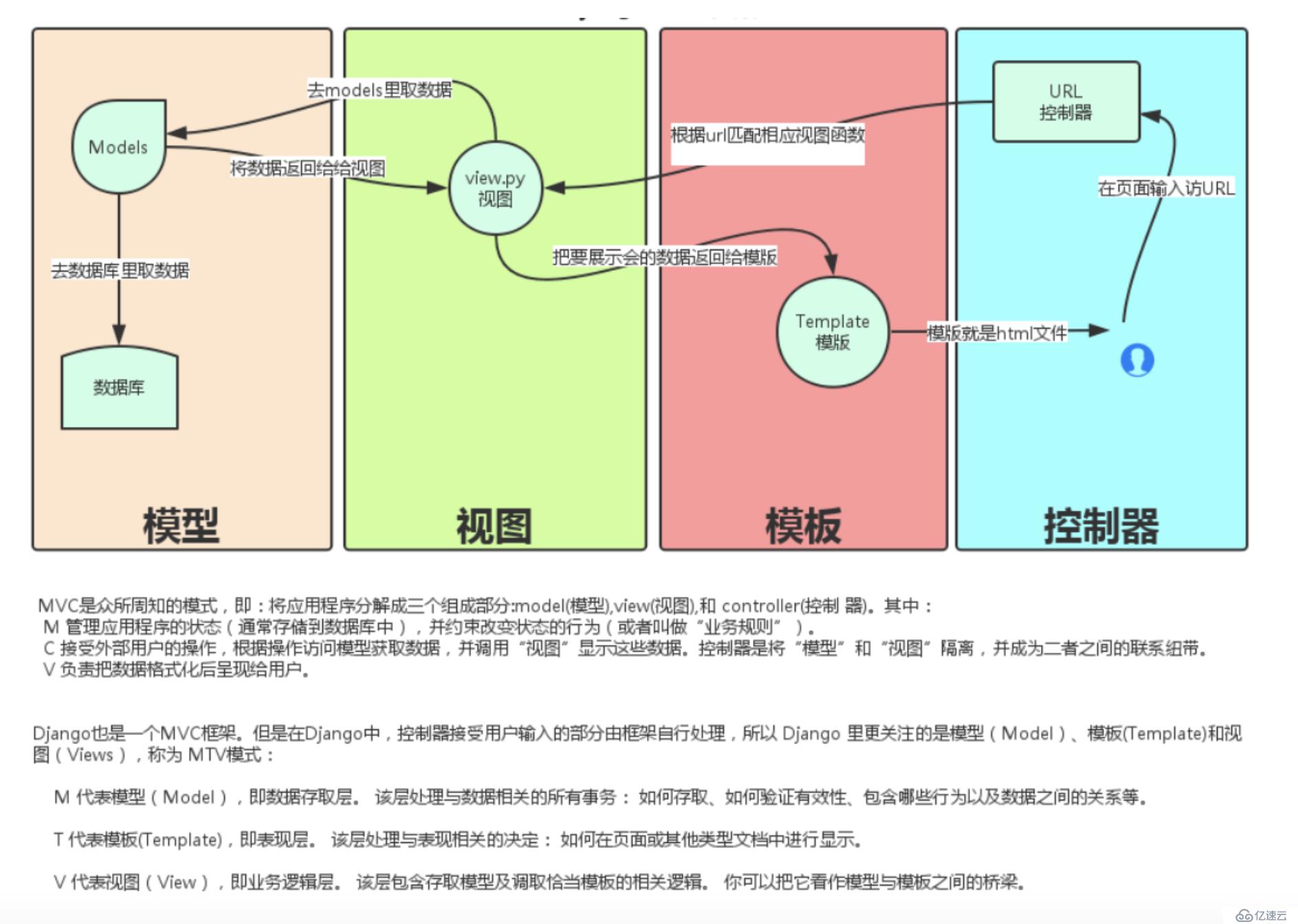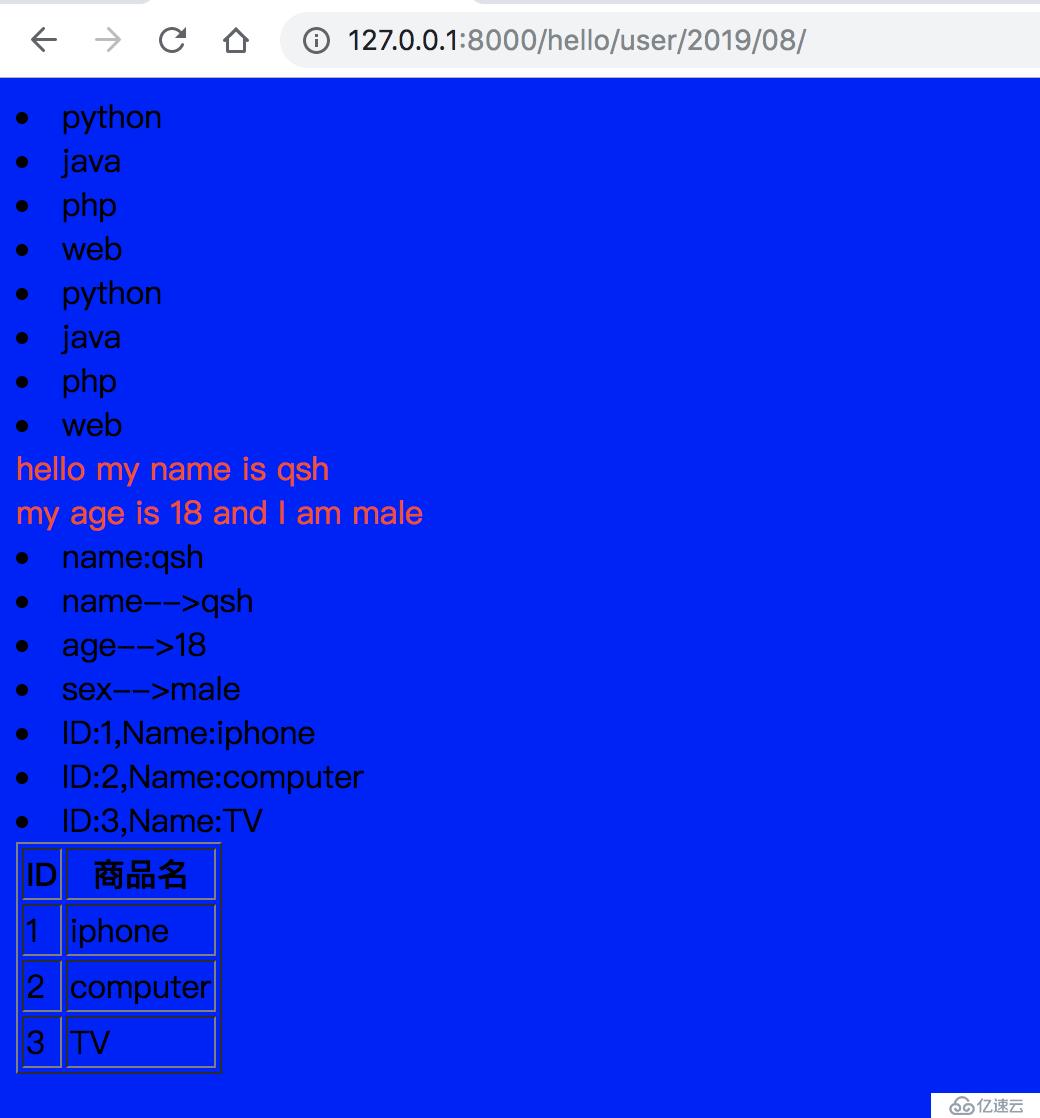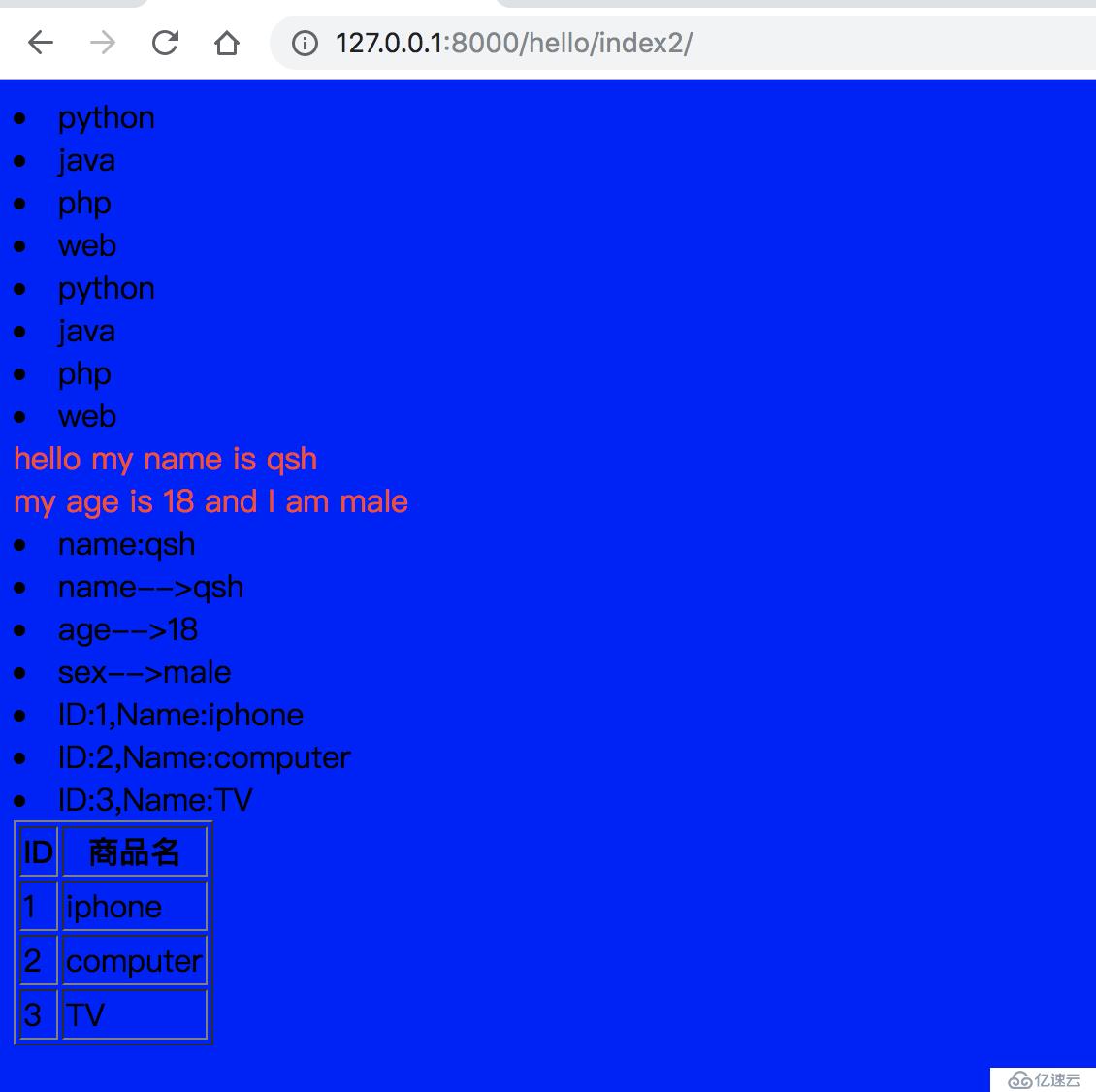您好,登錄后才能下訂單哦!
您好,登錄后才能下訂單哦!
1、安裝Django
$ pip install django==2.2.0
$ pip list
Package Version
---------------- -------
backcall 0.1.0
decorator 4.4.0
Django 2.2
$ python -m django --version
2.22、安裝 mysqlclient$ pip3 install mysqlclient
如果報錯,請參考:https://blog.51cto.com/qiangsh/2422115
1:用戶打開一個網址的步驟
從用戶角度分析一個框架(網站)都需要那些零件
經典的MVC(MTV)框架是怎么來的呢?
2:以此設計邏輯分析django框架
首先創建django項目,查看下項目的目錄結構
使用 django-admin 來創建 devops 項目:
django-admin.py startproject devops查看項目的目錄結構:
$ tree devops/
├── devops
│?? ├── __init__.py
│?? ├── settings.py
│?? ├── urls.py
│?? └── wsgi.py
├── manage.py目錄說明:
2.1:訪問URL——為啥訪問 http://ip/admin就訪問到了管理后臺
# URL總入口
$ cat devops/urls.py
from django.contrib import admin
from django.urls import path
urlpatterns = [
# 訪問admin的請求交給了admin.site.urls處理,而admin是django自帶的APP
path('admin/', admin.site.urls),
]
# devops項目總配置文件
$ cat devops/settings.py
……
# Django自帶的APP都已經在這里注冊好了,我們自己定義的app也得在這里注冊
INSTALLED_APPS = [
'django.contrib.admin',
'django.contrib.auth',
'django.contrib.contenttypes',
'django.contrib.sessions',
'django.contrib.messages',
'django.contrib.staticfiles',
'hello.apps.HelloConfig', # 添加此行
]
……
# 這些django自動的APP在哪呢?
$ ls ~/env3/lib/python3.6/site-packages/django/contrib/
admin admindocs auth contenttypes flatpages gis humanize __init__.py messages postgres __pycache__ redirects sessions sitemaps sites staticfiles syndication
# 找到admin這個APP的url
$ vim ~/env3/lib/python3.6/site-packages/django/contrib/admin/sites.py
……
def urls(self):
return self.get_urls(), 'admin', self.name
……2.2:用戶發出的請求是數來處理的呢
URL已經將用戶請求帶到了admin的內部。用戶訪問admin后臺其實提交了兩個操作,第一是get請求admin頁面,admin給了一個列表框,要求填寫用戶名密碼;第二個是post請求是把用戶密碼提交給admin,那么這兩個請求是誰來處理的呢——view
# admin app的view目錄下編寫應對用戶請求的各種邏輯,源碼可自行查看
$ ls ~/env3/lib/python3.6/site-packages/django/contrib/admin/views/
autocomplete.py decorators.py __init__.py main.py 2.3:數據存在哪里?數據表結構哪里定義的呢?vim ~/env3/lib/python3.6/site-packages/django/contrib/admin/models.py
2.4:用戶看的頁面各種樣式在哪里定義的呢?
$ ls ~/env3/lib/python3.6/site-packages/django/contrib/admin/templates/admin/
404.html auth change_form_object_tools.html date_hierarchy.html filter.html login.html prepopulated_fields_js.html
500.html base.html change_list.html delete_confirmation.html includes object_history.html search_form.html
actions.html base_site.html change_list_object_tools.html delete_selected_confirmation.html index.html pagination.html submit_line.html
app_index.html change_form.html change_list_results.html edit_inline invalid_setup.html popup_response.html widgets1、創建工程django-admin.py startproject devops
2、創建一個APP(應用)
Django框架的組織架構:一個項目(Project)下可以有多個應用(APP),每個應用下面都五臟俱全的MTV模塊(就是以py結尾的文件),每個模塊各司其職。
qiangsh@Dream ~/D/P/5/Django_day1> cd devops/
qiangsh@Dream ~/D/P/5/D/devops> python manage.py startapp hello
qiangsh@Dream ~/D/P/5/D/devops> tree hello
hello
├── admin.py # 后臺管理文件
├── apps.py # app命名文件
├── __init__.py # 初始化文件,有他表示這是一個包
├── migrations # 數據遷移文件
│ └── __init__.py
├── models.py # 模型文件
├── tests.py
├── urls.py # 定義路由,默認沒有,自己加的
└── views.py # 邏輯處理,即控制器2.1:全局配置文件中注冊新創建的APP
$ cat devops/settings.py
INSTALLED_APPS = [
'django.contrib.admin',
'django.contrib.auth',
'django.contrib.contenttypes',
'django.contrib.sessions',
'django.contrib.messages',
'django.contrib.staticfiles',
'hello.apps.HelloConfig', # 添加此行
]注釋下面一行,解決權限問題
MIDDLEWARE = [
'django.middleware.security.SecurityMiddleware',
'django.contrib.sessions.middleware.SessionMiddleware',
'django.middleware.common.CommonMiddleware',
#'django.middleware.csrf.CsrfViewMiddleware', #注釋此行,解決跨域
'django.contrib.auth.middleware.AuthenticationMiddleware',
'django.contrib.messages.middleware.MessageMiddleware',
'django.middleware.clickjacking.XFrameOptionsMiddleware',
]2.2:編寫處理邏輯代碼(控制器)
$ cat hello/views.py
# Create your views here.
from django.shortcuts import render
from django.http import HttpResponse,QueryDict
# 練習一
# def index(request):
# return HttpResponse("<p>Hello World,Hello, Django</p>")
# 練習二
# 位置參數的接收方法---函數中的參數和URL中的位置一一對應(嚴重依賴參數順序且代碼可讀性不好,不推薦)
def index(request,year=2018,month=8):
# 普通參數的接受方法
# 方法一、設置默認值的方式獲取數據更優雅
year = request.GET.get("year","2019")
# 方法二、直接獲取數據,沒有傳值會報錯,不建議使用
month = request.GET["month"]
return HttpResponse("year is %s,month is %s" %(year,month))
# 關鍵字傳參數(?<參數名>參數類型)——視圖中直接通過參數名獲取值(最常用)
def index2(request,**kwargs):
# 請求參數接收,默認為GET請求,通過method判斷POST請求
if request.method == "POST":
print(request.scheme) # http
#print(request.method) #POST
print(request.body) #b'year=2019&month=11'
#print(type(request.body))
print(QueryDict(request.body).dict()) #{'year': '2018', 'month': '08'}
#print(type(QueryDict(request.body).dict()))
print(request.POST) #<QueryDict: {'year': ['2018'], 'month': ['08']}>
print(type(request.POST)) #<class 'django.http.request.QueryDict'>
data = request.POST
year = data.get('year',2018)
month = data.get('month',8)
else:
print(request)
print(request.method)
print(request.META)
print(request.body)
print(kwargs)
year = kwargs.get('year',2018)
month = kwargs.get('month',8)
return HttpResponse("year is %s,month is %s" %(year,month))
def user(request,**kwargs):
if request.method == "POST":
pass
else:
user = {'name':'qsh','age':'18'}
return render(request,'index.html',{'user':user})2.3:編寫提供給用戶訪問的路由URL
URL的設計比較優雅的方式:APP自己定義自己的url,然后在全局統一入口的url文件中引入即可
#設計自己的url, 用戶訪問/hello就會把請求發給views模塊中的index方法
$ cat hello/urls.py # 系統沒有,需要自己建立
from django.urls import path,re_path
from . import views
urlpatterns = [
# 2.3.1:普通傳參url基本和無參數一樣
# 請求方式 http://127.0.0.1:8000/hello/hello/?year=2019&month=10
path('index/', views.index, name='index'),
path('hello/',views.index2, name='index'),
# URL中每個位置數值和view中定義的參數順序一一對應(代碼可讀性不好,不推薦)
# 2.3.2:位置匹配
# 請求方式 http://127.0.0.1:8000/hello/hello/2019/08/
re_path('hello/([0-9]{4})/([0-9]{2})/', views.index2, name='index2'),
# 2.3.3:關鍵字匹配(最優雅) (?<參數名>參數類型)??視圖中直接通過參數名獲取值(最常用)
re_path('user/(?P<year>[0-9]{4})/(?P<month>[0-9]{2})/', views.user, name='user'),
]#在統一訪問url入口將hello的url引入進來(注冊子app的url)
$ cat devops/urls.py
from django.contrib import admin
from django.urls import path,include
urlpatterns = [
path('admin/', admin.site.urls),
path('hello/',include('hello.urls'),name="hello"),
]
# 總入口文件又多了一層路徑,所以最終的訪問路徑為 http://ip:8000/hello/<app_url>/#最終路徑如下
$ tree
.
├── devops # devops工程自動的全局app
│ ├── __init__.py
│ ├── settings.py
│ ├── urls.py # 全局路由入口
│ └── wsgi.py
├── hello # 自己創建的app
│ ├── admin.py
│ ├── apps.py
│ ├── __init__.py
│ ├── migrations
│ │ └── __init__.py
│ ├── models.py
│ ├── tests.py
│ ├── urls.py # 每個app自定義的路由入口,需要注冊
│ └── views.py
└── manage.py
3 directories, 13 files3、啟動工程
python manage.py runserver 0.0.0.0:8000小結
以上這個小栗子其實只用到了MTV中的View以及URL(url是view的指引,這兩個會一起出現,統稱為V),數據庫和模板都沒用上,故而體驗不好,功能也簡單,好歹是跑通了。接下來一個完整的項目。在此之前把V和URL的最佳實戰知識學習下
hello的小栗子主要實現了用戶發起請求,然后Django根據用戶發起的url路徑找到對應的處理函數,然后將內容簡單返回而已。但現實中用戶的請求可不是這么簡單。用戶都會有那些請求呢,大致可以分為兩類讀和寫,讀有帶參數和不帶參數兩種場景,寫肯定是帶參數了
Django的MTV模式本質上和MVC是一樣的,也是為了各組件間保持松耦合關系,只是定義上有些許不同
Django的MTV分別是值:

4、添加html文件
#添加模板目錄 'DIRS': []
$ cat devops/settings.py
TEMPLATES = [
{
# 模板引擎,翻譯給前端展示
'BACKEND': 'django.template.backends.django.DjangoTemplates',
# 模板目錄,當前目錄下創建templates
'DIRS': [BASE_DIR+"/templates"],
# 如果統一目錄沒有,就在app自己目錄查找
'APP_DIRS': True,
'OPTIONS': {
'context_processors': [
'django.template.context_processors.debug',
'django.template.context_processors.request',
'django.contrib.auth.context_processors.auth',
'django.contrib.messages.context_processors.messages',
],
},
},
]
#配置解釋
* BACKEND 是一個指向實現了Django模板后端API的模板引擎類的帶點的Python路徑。內置的后有django.template.backends.django.DjangoTemplates 和 django.template.backends.jinja2.Jinja2.兩個模板差不多
* DIRS 定義了一個目錄列表,模板引擎按列表順序搜索這些目錄以查找模板源文件。默認會先找templates目錄
* APP_DIRS 告訴模板引擎是否應該進入每個已安裝的應用中查找模板。每種模板引擎后端都定義了一個慣用的名稱作為應用內部存放模板的子目錄名qiangsh@Dream ~> cd devops
qiangsh@Dream ~/devops> mkdir templates/
qiangsh@Dream ~/devops> cat index.html
<html xmlns="http://www.w3.org/1999/xhtml" xml:lang="en" lang="en">
<head>
<meta http-equiv="Content-Type" content="text/html;charset=UTF-8" />
<title>python訓練營</title>
<head>
<body >
myname is {{ user.name }}, age is {{ user.age }}
</body>
</html>5、瀏覽器訪問
5.1:帶參數的讀——get
# 普通參數
http://127.0.0.1:8000/hello/index/?year=2019&month=10
# 位置參數
http://127.0.0.1:8000/hello/hello/2018/01/
5.2:帶參數的寫——post
#shell終端,模擬django表單POST提交數據
curl -X POST http://127.0.0.1:8000/hello/hello/ -d 'year=2019&month=11'

http://127.0.0.1:8000/hello/user/2019/08/
6、QueryDict
通過上面演示我們知道無論GET/POST請求,接受參數的數據類型都是QueryDict。QueryDict到底做了什么事情呢
在HttpRequest 對象中,GET 和POST 屬性是django.http.QueryDict 的實例,它是一個自定義的類似字典的類,用來處理同一個鍵帶有多個值。無論使用GET,POST方式,他們最終都是通過QueryDict方法對傳入的參數進行處理
# QueryDict常用方法
>>> QueryDict('a=1&a=2&c=3') # 對用戶請求的數據處理
<QueryDict: {'a': ['1', '2'], 'c': ['3']}>
>>> QueryDict.get(key, default=None) # 獲取數據
>>> q = QueryDict('a=1&a=2&a=3')
>>> q.lists()
[('a', ['1', '2', '3'])]
>>> q = QueryDict('a=1&b=3&c=5')
>>> q.dict()
{'a': '1','b':'3','c':'5'}1、修改邏輯代碼
$ cat hello/views.py
def user(request,**kwargs):
if request.method == "POST":
pass
else:
user = {'name':'qsh','age':'18'}
title = "devops"
books = ['python','java','php','web']
people = {'name':'qsh','age':18,'sex':'male'}
products = [{'pid': 1, 'name': 'iphone'}, {'pid': 2, 'name': 'computer'}, {'pid': 3, 'name': 'TV'}]
return render(request,'index.html',{'title':title,'books':books,'people':people,'user':user,'products':products})
2、修改html頁面
$ cat templates/index.html
<html xmlns="http://www.w3.org/1999/xhtml" xml:lang="en" lang="en">
<head>
<meta http-equiv="Content-Type" content="text/html;charset=UTF-8" />
<title>{{title}}</title>
<head>
<body >
{# 接受列表的第N個值,很low不推薦 #}
<li>{{books.0}}</li>
<li>{{books.1}}</li>
<li>{{books.2}}</li>
<li>{{books.3}}</li>
{# for循環標簽 ,渲染books列表 #}
{% for book in books %}
<li>{{book}}</li>
{% endfor %}
{# 接受字典中的定義的值 #}
<div >hello my name is {{people.name}} </br>
my age is {{ people.age }} and I am {{ people.sex }}
</div>
{# if標簽使用,判斷user是否存在 #}
{% if people %}
<li>name:{{people.name}}</li>
{% else %}
用戶不存在
{% endif %}
{# for循環輸出字典里所有的key,value #}
{% for k,v in people.items %}
<li>{{k}}-->{{v}}</li>
{% endfor %}
{# 列表頁展示 #}
{% for product in products %}
<li>ID:{{product.pid}},Name:{{product.name}}</li>
{% endfor %}
{# 列表頁展示,表格輸出 #}
<table border="1">
<thead> {# 定義表格的表頭 #}
<tr> {# 行 #}
<th>ID</th> {# 表頭單元格 - 包含表頭信息 #}
<th>商品名</th>
</tr>
</thead>
<tbody>
{% for product in products %}
<tr>
<td> {{product.pid}} </td> {# 標準單元 - 包含數據 #}
<td> {{product.name}} </td>
</tr>
{% endfor %}
</tbody>
</table>
</body>
</html>3、瀏覽器訪問
http://127.0.0.1:8000/hello/user/2019/08/
1、修改邏輯代碼
$ cat hello/views.py
#添加模塊
from django.http import HttpResponse, QueryDict, HttpResponseRedirect
from django.shortcuts import render
from django.urls import reverse
#新建登錄函數
def login(request, **kwargs):
data = ""
if request.method == "POST":
print(request.POST)
print(QueryDict(request.body).dict())
username = request.POST.get('username','qsh')
passwd = request.POST.get('password','123456')
if username == "admin" and passwd == "123456":
# data = "welcome you %s" % username
return HttpResponseRedirect(reverse("hello:user"))
# return HttpResponseRedirect("/hello/hello/")
else:
data = "your passwd or username is wrong,plaeace again"
return render(request, 'login.html', {'data':data})2、創建登錄html
$ cat templates/login.html
<html>
<body>
<!--登陸表單-->
<form action="{% url 'hello:login' %}" method="post">
<!--用戶名-->
<input name="username" type="text" placeholder="用戶名"> </br>
<!--密碼-->
<input name="password" type="password" placeholder="密碼"> </br>
<button type="submit">登錄</button>
</form>
{% if data %}
<h2>{{ data }}</h2>
{% endif %}
</body>
</html>3、路由
$ cat hello/urls.py
from django.urls import path,re_path
from . import views
app_name = 'hello'
urlpatterns = [
path('index/', views.index, name='index'),
path('hello/',views.index2, name='hello'),
path('login/',views.login, name='login'),
path('index2/',views.user, name='user'),
re_path('hello/([0-9]{4})/([0-9]{2})/', views.index2, name='index2'),
re_path('user/(?P<year>[0-9]{4})/(?P<month>[0-9]{2})/', views.user, name='user'),
]4、瀏覽器訪問
http://127.0.0.1:8000/hello/login/
用戶名密碼錯誤,效果如下。
輸入正確 跳轉http://127.0.0.1:8000/hello/index2/
模板template如何接收View的各種數據類型并渲染已經完成,但頁面還是不夠美麗,就得引出前端內容了——Bootstrap(HTML/CSS/Jquery)
學習網站:
https://v3.bootcss.com/
https://v3.bootcss.com/css/
免責聲明:本站發布的內容(圖片、視頻和文字)以原創、轉載和分享為主,文章觀點不代表本網站立場,如果涉及侵權請聯系站長郵箱:is@yisu.com進行舉報,并提供相關證據,一經查實,將立刻刪除涉嫌侵權內容。